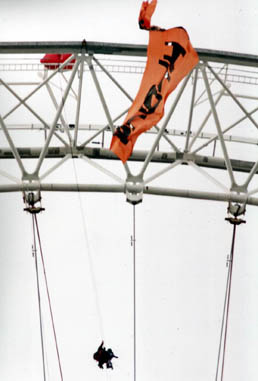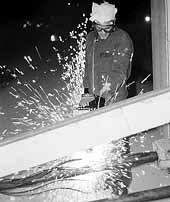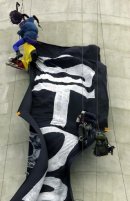| zurück
The Itoiz Reservoir Project SOME BASIC DATA
The Itoiz Reservoir Project is located in the north-east of Basque Country, in the province of Nafarroa, 30 Km away from Iruña (Pamplona). If constructed, the Irati and Urrobi rivers would flow to the reservoir. It would have a capacity of 418 Htm3, with a dam of 135 meters high and 35 Km length, and would flood 1.100 Ha. ECOLOGICAL AND SOCIAL DISASTER With the construction of the dam, nine villages of the Artze, Longida and Irati valleys would disappear, and six villages would partially be flooded. Historical and artistic heritage would be lost, including ways of live based on respect of Earth, that have lasted until the present day. The Itoiz reservoir would flood three areas which have been declared Natural Parks (Txintxurrenea, Gaztelu and Iñarbe), where the European Union has created protected areas and two Z.E.P.A.S. (Special Zones for Bird Protection).These laws show the importance of natural richness of this area of transitionbetween the Pyrenees and the Mediterranean Sea, and the necessity to safeguard species in extinction. This is the case of the alimoche, golden eagle, vulture, imperial owl, desmán and otter (which has already disappeared due to the works in the dam).
(organisation that administrates the use of water), Pamplona having 3 or 4 times larger supply of water than any big city (1430 litres per person and day). No serious blueprint has yet been presented to show how this water would be canalised to Pamplona. Electricity production is another excuse used. The planned power plant would produce 52 GW/H, while the reservoir would flood four power plants in the Irati banks, which at this moment produce 34.6 GW/H altogether, and which will be compensated with 5.000 million pesetas. THE REAL PURPOSES FOR THE CONSTRUCTION OF THE ITOIZ DAM The main reason for the construction of the Itoiz reservoir is to supply water to areas in the Mediterranean shore, from the Pyrenees, with speculative and developist aims (tourism, golf courses,...). A territorial, social and ecological imbalance incompatible with a rational administration. CORRUPTION AROUND
THE PROJECT
Since the beginning, this project is characterised by corruption. The construction works were fraudulently appointed: Antonio Aragon, ex-minister of the Navarra government, and ex-president of the C.H.E., got paid 720 million pesetas for the appointments of the works. He and Gabriel Urralburu, ex-president of the Navarra government, were imprisoned for the appointment of this and other construction works. The following president Javier Otano had to resign for the same reasons; he is pending trail at the present time. Also, Leoncio Castro, the head of security of the construction works, was one of the chiefs of G.A.L. (paramilitary group created by the Spanish government that killed 30 people). Without any explanation, the budget rose from 16.000 million to 30.000 million of pesetas. ILLEGALITY OF
THE PROJECT
The technical project of the Itoiz reservoir was overturned by the Spanish High Court (29/9/1995). This cancellation was corroborated by the Supreme Court (14/7/97). But none of these actions have stopped the construction works. At this moment, the principal dam is already built, and the new road that substitutes the one that would be flooded will soon be inaugurated. Then, the construction of the secondary dam will begin. In 1994 the "Coordinadora de Itoiz" made a formal complaint about the project at the Environmental Commission of the European Union. But it was filed by the Commission. In 1998 the European Ombudsman declared that the filing of the demand was not justified, and that it constituted a case of "bad administration". The reason for the mismanagement of the petition was the political pressure by the Navarra and Spanish governments. In top of this, the Navarra government contracted the mafiosi Burson-Marsteller company (the transnational for public opinion creation) to convince mass media and society of the need of the reservoir. This famous firm has also worked advising several dictatorships and polluting companies. ABSOLUTE LACK OF SECURITY A recent research carried out by Antonio Casas (head of the Department of Geo-Dynamics at the University of Zaragoza), shows that the left slope where the principal dam is based has great problems of instability. This could have "catastrophic consequences", becoming more dangerous with the filling and emptying of the reservoir, and in the case of seismic movements. Three million cubic meters of soil could slide and block the drains at the bottom, overflowing the dam (as it happened in 1963 in the Italian town of Vaiont, causing 2000 casualties). It could also break the dam (as it was the case in the Spanish town of Tous where dozens of people died). In a study developed by the Ministry of Environment, the Itoiz dam is labelled as a "maximum risk" construction. Both the Spanish and Navarran governments have deliberately hidden all studies related to the security of the dam, since well before the beginning of the construction works until the present day. MILITARISATION OF THE AREA The works have brought the complete militarisation of the area. In the skirts of the dam a barrack has been built for the 60 permanent members of the Guardia Civil. In top of this we have to add 30 security guards. And with the 3 Guardia Civil barracks that are located in the surroundings, Itoiz is one of the most militarised areas of Europe. That has translated in the continuous police harassment of the inhabitants: daily road checks, body searches, threats and more than "suspicious" burnings of social centres and private vehicles. CUTTING THE CABLES In the summer
of 1995, the National Court declared null and illegal the project of Itoiz
reservoir, and asked the "Coordinadora de Itoiz" for a payment of 23.000
millions pesetas, as a fee for stopping the works. Seeing that the construction
works didn't stop, but its rhythm accelerated, "Solidari@s con Itoiz" decided
to paralyze them with a daring action.
PENAL
CONSEQUENCES OF THE ACTION
Two years after the action, the trial against the 8 members of "Solidari@s con Itoiz" took place at the Navarra's Provincial Court. They were confronted with five different condemn requests, being the most disproportionate the request of 19 years of prison for each, coming from the Navarra government. They were sentenced to 4 years and 10 months of prison term for illegal detention (kidnapping). These prison terms are disproportional compared to the 3 weekends of house arrest to which they were sentenced for cutting the cables. They were also sentenced to pay 1.800 millions worth in compensations. The judicial power confronted the fact that the cutting of the cables was not a crime punishable with a prison term, and it contradicted its own jurisprudence by labelling a detention that did not last longer that 5 minutes as a kidnapping. The High Court had to refer to a sentence of 1874, to be able to affirm so. The proof that the "kidnapping" time was not longer than five minutes is shown in a video which was used as
The Itoiz Reservoir Project OPPOSITION AGAINST THE ITOIZ RESERVOIR COORDINADORA DE ITOIZ The "Coordinadora de Itoiz" was born in 1985 (the same year in which talks began about this project) as an opposing group against the Itoiz reservoir. During these years, its principal activities have been to inform, distribute several technical studies, mobilise society and denounce judicially the illegality of the project at the different court levels. SOLIDARI@S CON ITOIZ On February 1995, a year and a half after the beginning of the construction works, "Solidari@s con Itoiz" was born. The intention was to create a new front of struggle: that of direct, public and non-violent action. Within civil disobedience action strategy to defend the Earth. Our actions are focused in the headquarters of the companies and government agencies responsible for the construction works, or at the construction site. When the civil disobedience actions ends, the members of the group remain in the place without opposing any resistance to police detention. Even though we have been many times battered by the different police forces and security guards. Due to these actions, members of Solidari@s have been prosecuted 5 times, with the result of eight of them being imprisoned for 2 months (due to the cut of the cables) and another one imprisoned for 16 months. |


